Living Planet
Nature · Earth · ClimateNature Notes: January 2023
NATURE'S KISS
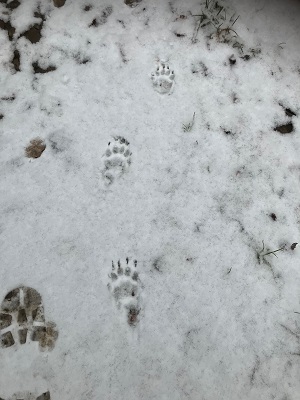
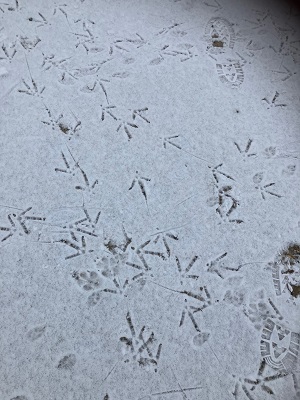
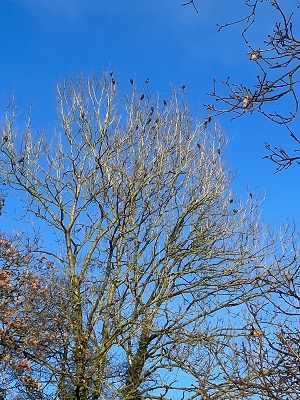
There's always an almost unearthly stillness and silence after our first snowfall of winter. Very early on a Monday morning in mid-December, the village was still blanketed by that muffled quiet and yellow white light which mutes all sounds of nature and makes one feel like an explorer stepping out on unknown territory, on as yet, unbroken snow. Yet signs of life were all too instantly obvious - fox tracks in varying sizes as they'd busily trotted back and forth, wending their way, alongside a few 'pounce and snout' marks, where they'd leapt upon the odd small unsuspecting mammals sheltering beneath. In places there were two sets of prints, possibly a dog following a vixen, waiting for her to come into oestrus - as their breeding season peaks after Christmas and continues on into January. There were also signs of rabbits seemingly lang-laufing off-piste, a deer that had bounded on and off the path, a badger that seemed to have walked alongside a fox and a mouse and later, the jail-bird arrows of dozens of pheasants' feet. All sights and sounds of the creatures themselves were now, temporarily hidden. Only later, when the low pastel candyfloss cloud curtains opened onto a stage of deep sky blue and brilliant sunshine, did the perceptible warmth prompt a constellation of starlings into excited chattering song, belying their presence in the very top of a tree, and the yellow streaked wings of a charm of goldfinches, to swim through the air, like a shoal beneath.
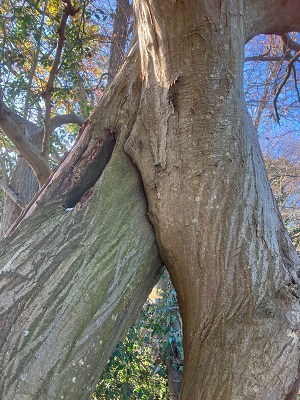
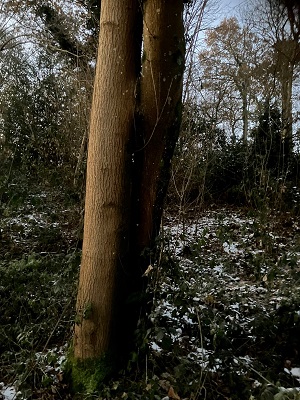
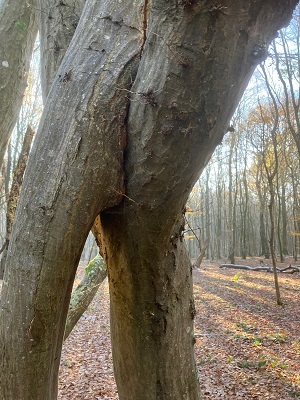
The sudden cold temperatures in the weeks preceding and after the snow, down to -9C one morning, saw many trees lose their remaining blankets of golden leaves rather suddenly, revealing strong sculptural shapes beneath. Thick, smooth, bare trunks and branches, in shiny grey silks or rough, patterned bark, stood now proudly trimmed by Jack Frost's stroke of ermine. Many stood shoulder to shoulder, side-by-side, especially those where co-dominant stems resembles two or more trunks rising from the same base. Some of our trees, even of different species, could be seen hugging, branches gently touching, or trunks entwined in a firm embrace as if to keep out the cold, whereas some, you may have already noticed are actually 'fused' and continue to grow together. Known as 'inosculation' (Latin: to kiss inwards), 'tree-snogging' is a natural phenomenon which occurs when two individual trees growing in close proximity actually join their vascular systems, melting into each other as one. Once you start looking out for them, you may wonder how you've never noticed them before. January is a great time to observe their loving art.
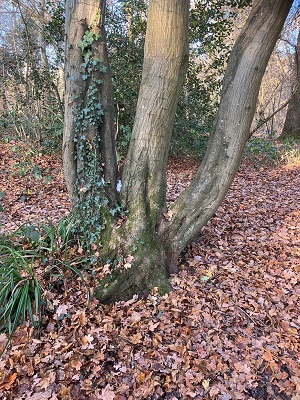
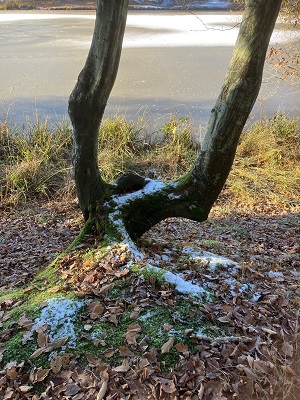
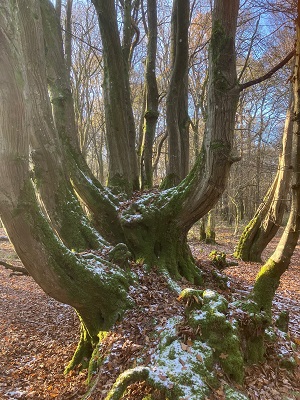
This month can often seem like another realm, still asleep in winter, a time when all is 'on pause' including us, as we reflect on the year ahead, but other interspecies action is often evident in murmurations comprising of flocks of different birds, gathering together for warmth and protection. Many creatures, from insects, to birds, to small mammals and even bats, have been surviving the temperatures, out of sight, deep in their hollows of the same tree. They may be harder to spot whilst out on walks, but tawny and barn owls have been audible at night and in my garden a nuthatch keeps racing to the feeder and back from his hole in the old yew trunk. I also have a relatively new family of residents who, are either stock doves (which like the tawny owls nest in tree hollows) or feral rock doves. It's hard to tell as they seem to be a colourful hybrid with iridescent bottle green, pink and blue-grey plumage with black tinged wings and bars but also white flashes, borrowed from the wood pigeon. What is apparent is their love of seeds which is probably what's attracting these normally farm-loving birds to the garden. Did you know that pigeons are monogamous, and all varieties are very like us in one particular way, which is that they feed milk to their babies? They produce milk a lot like ours, in that it contains fats, proteins and immune-boosters and is stimulated by the hormone prolactin but instead of mammary glands, it gathers in their crops (at the back of their throats) where they bring it straight up and into their chicks' mouths. It may seem early to be thinking about nesting, but feral pigeons breed all year around, rooks (who also mate for life and are demonstratively affectionate as they groom each other) also breed early and badger sows often give birth underground in January or February, so their young are ready to emerge from their dens during the first flush of spring.
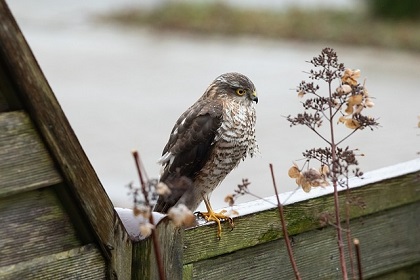

January is a month when, as well as owls, other birds of prey are ready to pounce - so keep your eyes peeled in the garden, especially in an around your feeders which are usually particularly busy this time of year, as predators, such as Sparrow-hawks, will also be attracted to our smaller birds as well as woodpeckers and blackbirds. One good excuse to keep 'casting your eye' is to take part in the Big Garden Birdwatch between 27th-29th January 2023 (visit the RSPB website to register for their free guide). We've lost 38 million birds from UK skies in the last 50 years and your birdwatch results will help to monitor how UK birds are faring in the face of our nature and climate emergency.
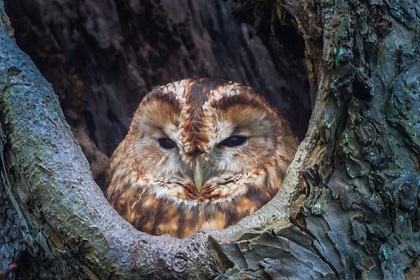
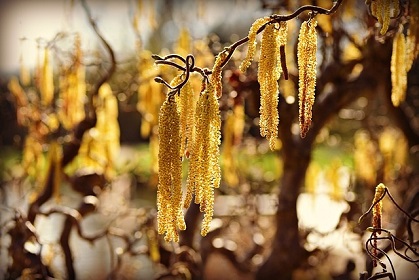
As the daylight slowly increases, you may notice lambs' tails (or catkins) waving head-height in the breeze, offering some of the first comforting signs of spring, whilst snowdrops spring from underfoot, signifying a time of new beginnings and hope and the delight of gradually increasing birdsong reaches our ears. May the space and stillness at the start of this year reconnect you with every living thing and may nature's embrace continue to provide a pleasure for all of your senses this season and in the year ahead.
Wishing you all a very Happy New Year!